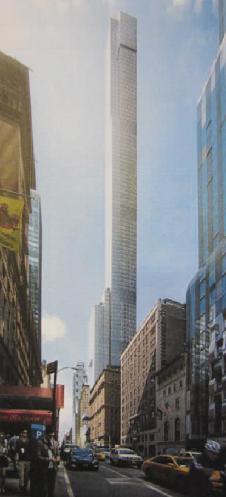
Rendering of Proposed Mixed Use Tower, located at 217 West 57th Street, New York. Image Credit: Adrian Smith + Gordon Gill Architecture.
Skyscraper to be built as-of-right, but requires Landmarks to review and approve its impact on adjacent individual landmark. On October 22, 2013, the Landmarks Preservation Commission voted to issue a certificate of appropriateness to Extell Development, despite one dissenting vote, to allow a portion of a new planned tower to cantilever over the individually landmarked American Fine Arts Society building, located at 215 West 57th Street in Midtown Manhattan. The tower, which is intended to rise to over 1,400 feet, will house a Nordstrom department store at its base, and residences and a hotel above the store. The French Renaissance-style landmark building has been continuously occupied by the Art Students League of New York since its construction in 1892.
The cantilevered portion of the building would be visible from multiple street vantages. The cantilever would extend 28 feet into the landmark lot, approximately one-third of the lot. The section intruding into the air above the Art Students League would start at 290 feet above the street and 195 feet above the roof of the art school, which is equivalent to “20 stories of air.” The cantilever would be set back 80 feet from the street wall.
At the public hearing, Gary Barnett of Extell stated that the project, which would constitute “a significant addition to the New York City skyline,” would create over 1,300 jobs and generate over $1 billion in tax revenue for the City over 20 years. Barnett said the proposal would in no way detract from the landmark. Preservation Consultant Bill Higgins argued that the cantilever and the landmark would “exist in different planes of urban experience.”
Architect Gordon Gill, of Adrian Smith and Gordon Gill Architecture, said the glass-faced building would be composed of cantilevers, including a “sky lobby” 139 feet above the street. He said the cantilever over the landmark would give the building “a sense of scale” and a “modulation of the texture” of the otherwise sheer side façade. Gill said the transparent façade of the new building would provide “a contrast” to the stone-clad landmark, and “add texture and animation to the street.”
A representative of Manhattan Community Board 5 recommended a denial of the certificate, stating that the tower would be the second-tallest building in Manhattan and the cantilever would set a poor precedent. Ronda Wist of the Municipal Art Society argued that Landmarks should withhold approval until Extell instituted a protection plan for the Art Students League. She also testified that the new building’s all-glass façade would not relate well to the masonry landmark, and that a study of the project’s impact on the already congested neighborhood is required. The New York Landmarks Conservancy’s Alex Herrera also spoke in opposition, calling the cantilevered section a “huge mass hovering over the Art Students League.” One member of the League testified that the project would block natural light from entering the building through its rooftop skylights. Some area residents expressed concerns about safety, noting that a crane collapse had previously occurred at an Extell construction site, with one comparing the construction of the cantilever to a “sword of Damocles.”
Executive Director of the Art Students League Ira Goldberg said the funds from the League’s sale of its air rights to Extell would ensure the school’s longevity and allow it to make improvements. Goldberg attested that the project’s impact on the building would be minimal. Rick Bell, Executive Director of the New York chapter of the American Institute of Architects, praised the design of the planned tower, and said it would not negatively affect the landmark, and that the unique characteristics of the site and the project would prevent it from setting a precedent. A representative of the Hotel Trades Council spoke in favor, saying the project would create “quality middle-class jobs.”
Landmarks Counsel Mark Silberman advised the Commissioners that Landmarks’ purview was limited to the project’s impact on the landmarked site, particularly the appropriateness of the cantilever. Silberman also advised that the Commission was not reviewing the design and scale of the planned tower.
Chair Robert B. Tierney recommended approval of the application, finding that it would have “negligible impact to the landmark site,” and noting that the project would be a benefit to the City and the art school. Concurring, Commissioner Libby Ryan concurred said the project would not disrupt the complete perception of the landmark. Commissioner Diana Chapin found the cantilever to be an integral component of the proposed new structure, which would read as “part of the larger urban skyscape” that it did not impinge on the landmark. Commissioner Roberta Washington suggested that the cantilever be reduced so that it projects less into the landmarked site.
Commissioner Michael Goldblum did not find the proposal appropriate, determining that it did not reach the standard for architecture on an individually designated site. He said the impact of the project on the landmark was mitigated by the height of the cantilever, but the landmarked building would still be negatively affected. He also noted that the cantilever was not necessary for the development of the neighboring parcel.
The Commission voted to award the plan a certificate of appropriateness, with Commissioner Goldblum dissenting.
LPC: The American Fine Arts Society, 215 West 57th Street, Manhattan (14-9057) (Oct. 22, 2013) (Architect: Adrian Smith and Gordon Gill Architecture).
By: Jesse Denno (Jesse is a full-time staff writer at the Center for NYC Law)

